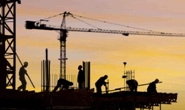Steel Markets

AGC: Construction Spending Soars in January
Written by Sandy Williams
March 2, 2020
Construction spending increased 1.8 percent to $1.369 trillion in January, according to a new analysis of federal data by the Associated General Contractors of America.
“Public spending on infrastructure, along with single-family housing, was exceptionally robust in January,” said Ken Simonson, the association’s chief economist. “While overall economic conditions remain favorable, future construction spending levels may be affected by the growing uncertainties related to the coronavirus and its impact on the supply chain for construction components, especially those manufactured in hard-hit countries.”
Although many construction items are sourced from China and other places disrupted by the virus, no contractors, to date, have reported projects impacted by supply issues.
AGC analysis shows public construction spending jumped 2.6 percent from December and 12.6 percent from a year earlier. The largest public category, highway and street construction, increased 11.7 percent. Educational construction, the next-largest segment, rose 4.1 percent year-over-year. Public spending on transportation infrastructure—airports, transit, rail and ports—climbed 11.5 percent. Other infrastructure categories posted even larger year-over-year gains: 13.9 percent for sewage and waste disposal, 35.5 percent for water supply and 23.8 percent for conservation and development.
Private residential spending increased 2.1 percent for the month, led by a 2.8 percent increase in single-family homebuilding. Multifamily construction remained flat. Private nonresidential spending increased 0.8 percent for the month and 0.5 percent compared to January 2019. Among the largest private nonresidential segments, power construction (electric power plus oil and gas field and pipeline projects) gained 5.7 percent year-over-year; commercial construction (retail, warehouse and farm structures) declined 5.5 percent; manufacturing construction increased 5.0 percent; and office construction rose 0.4 percent.
“Demand for construction is benefitting from the strength of the overall economy and robust public-sector investments in many types of construction projects,” said AGC CEO Stephen Sandherr. “The best way to keep the economy healthy and stave off any short-term impacts the coronavirus may have is for public officials to continue investing in needed infrastructure and other public works projects.”
AGC’s Simonson will speak on the construction economy as a panelist at Steel Market Update’s Steel Summit, set for Aug. 24-26 in Atlanta.

Sandy Williams
Read more from Sandy WilliamsLatest in Steel Markets

CRU: Sheet import demand softens as domestic price gains have slowed
US domestic sheet price gains have begun to slow as previously pulled-forward demand has led to a decline in orders.

CMC looks beyond Arizona micro-mill woes to long-term viability of construction mart
Despite the economic and geopolitical upheaval of the last five years, CMC President and CEO Peter Matt points out that the construction market has been an essential element of the way forward.

US importers face stricter rules under revamped S232 tariffs
“CBP expects full compliance from the trade community for accurate reporting and payment of the additional duties. CBP will take enforcement action on non-compliance," the agency said in a March 7 bulletin.

Steel exports rebound in January
US steel exports recovered to a five-month high in January after having fallen to a two-year low in December. This growth follows four consecutive months of declining exports.

Construction spending drops marginally in January
Construction spending edged down slightly in January, slipping for the first time in four months. The US Census Bureau estimated spending at a seasonally adjusted annual rate of $2,196 billion in January, down 0.2% from December’s downward revised rate. The January figure is 3.3% higher than a year ago. January’s result, despite the slight erosion, […]
